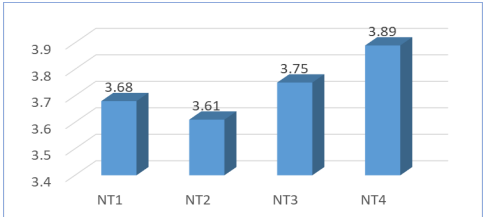Articles

Submission to VIJ 2024-06-08
Keywords
- Gen Z,
- Tourism ,
- TPB,
- Behavioral intentions ,
- Sustainability
Copyright (c) 2024 Nguyen Thi Viet Ha, Nguyen Thi Thu Hang, Le Khac Tai

This work is licensed under a Creative Commons Attribution 4.0 International License.
Abstract
Sustainable tourism development is one of the sustainable development orientations. Sustainable tourism development can be impacted by promoting increased interest in and selection of sustainable tourism destinations. This study aims to clarify the concept of sustainable tourism, examining the current factors influencing the intention to choose sustainable tourism. The subjects of the study are young people of Generation Z, in order to enhance and promote the travel intentions of this potential target group in the future. Based on survey data collected from 314 Gen Z travelers, the factors affecting Gen Z's intention to choose sustainable tourism in Vietnam are clarified.References
- Ha An. (2023), The proportion of tourism contributing to Vietnam's GDP is 1/3 of Thailand, the Philippines or Cambodia, accessed 06/03/2024, address: https://vietnambiz.vn/ty-le-du-lich-dong-gop-cho-gdp-cua-viet-nam-moi-bang-13-thai-lan-philippines-hay-campuchia
- Hall, C. M. (2021). Constructing sustainable tourism development: The 2030 agenda and the managerial ecology of sustainable tourism. In Activating critical thinking to advance the sustainable development goals in tourism systems (pp. 198-214). Routledge.
- National Assembly of the Socialist Republic of Vietnam (2017). The tourism laws. Law No. 09/2017/QH14 dated June 19, 2017, Hanoi.
- Khanh, Nguyen Chong (2021), Tourism development strategy in the face of current new challenges, accessed on 06/03/2024, address: https://tapchimattran.vn/kinh-te/chien-luoc-phat-trien-du-lich-truoc-nhung-thach-thuc-moi-hien-nay-40001.html
- Daud, N., & Rahman, S. A. (2011, August). Tourist attitudes towards sustainable tourism: empirical evidence from Malaysian National Park, Taman Negara. In International Conference on E-Business, Management and Economics (Vol. 3, pp. 254-258). IACSIT Press Hong Kong.
- Bramwell, B., & Lane, B. (1993). Sustainable tourism: An evolving global approach. Journal of sustainable tourism, 1(1), 1-5.
- Angelevska-Najdeska, K., & Rakicevik, G. (2012). Planning of sustainable tourism development. Procedia-Social and Behavioral Sciences, 44, 210-220.
- Mohamad, M., Ali, A. M., & Ab Ghani, N. I. (2011). A structural model of destination image, tourists’satisfaction and destination loyalty. International journal of business and management studies, 3(2), 167-177.
- Ha, N.T.V, & Hien, N.T (2024), Remote Working Intention of Gen Z in Vietnam. International Journal of Scientific Research and Management (IJSRM), 12(05), 1835-1844. https://doi.org/10.18535/ijsrm/v12i05.sh02
- Alegre, J. and Cladera, M. (2009), "Analysing the effect of satisfaction and previous visits on tourist intentions to return", European Journal of Marketing, Vol. 43 No. 5/6, pp. 670- 685
- Canny, L.U. (2013), "An Empirical Investigation of Service Quality, Tourist Satisfaction and Future Behavioral Intentions among Domestic Local Tourist at Borobudur Temple", International Journal of Trade, Economics and Finance, Vol. 4, No. 2.
- Haddouche, H., & Salomone, C. (2018). Generation Z & the tourist experience: Tourist stories and use of social networks. Journal of Tourism Futures, 4(1), 69–79. DOI: https://doi.org/10.1108/ JTF- 12-2017-0059.
- Murphy, P. E., & Price, G. G. (2012). Tourism and sustainable development. In Global tourism (pp. 167-193). Routledge.
- Hardy, A., Beeton, R. J., & Pearson, L. (2002). Sustainable tourism: An overview of the concept and its position in relation to conceptualisations of tourism. Journal of sustainable tourism, 10(6), 475-496.
- Machadol, p. M., 2003. Building community capacity for tourism development: conclusions. Wallingford, Oxfordshire (pp. 172–179). UK: CABI.
- Ko, T. G. (2005). Development of a tourism sustainability assessment procedure: a conceptual approach. Tourism management, 26(3), 431-445.
- Mowforth, M., & Munt, I. (2015). Tourism and sustainability: Development, globalisation and new tourism in the third world. routledge.
- Hysa, B., Karasek, A., & Zdonek, I. (2021). Social media usage by different generations as a tool for sustainable tourism marketing in society 5.0 idea. Sustainability, 13(3), 1018. Team: https:// doi.org/10.3390/su13031018.
- Cho, M., Bonn, M. A., & Han, S. J. (2018). Generation Z’s sustainable volunteering: Motivations, attitudes and job performance. Sustainability, 10(5), 1400.
- Berkup, S. B. (2014). Working with generations X and Y in generation Z period: Management of different generations in business life. Mediterranean journal of social Sciences, 5(19), 218-229.
- Bassiouni, D. H., & Hackley, C. (2014). 'Generation Z'children's adaptation to digital consumer culture: A critical literature review. Journal of Customer Behaviour, 13(2), 113-133.
- Dolot, A. (2018). The characteristics of Generation Z. E-mentor, 74(2), 44-50.
- Skinner, H., Sarpong, D., & White, G. R. (2018). Meeting the needs of the Millennials and Generation Z: gamification in tourism through geocaching. Journal of tourism futures, 4(1), 93-104.
- Holly D. Johnson & Sẩh Gage, 2023, Gen Z: The generation that knows how to make the most out of travel; https://www.bankrate.com/finance/credit-cards/how-gen-z-travels/
- Travel Trends Report, https://media.hopper.com/research/2023-travel-trends-report
- Nguyen, V. H., Truong, T. X. D., Pham, H. T., Tran, D. T., & Nguyen, P. H. (2021). Travel intention to visit tourism destinations: A perspective of generation Z in Vietnam. The Journal of Asian Finance, Economics and Business, 8(2), 1043-1053.
- Booking.com 2023 Sustainable Travel Report, Global Sustainable Tourism Council, https://www.gstcouncil.org/booking-com-2023-sustainable-travel-report/
- Lalicic, L., & Weismayer, C. (2018). A model of tourists’ loyalty: the case of Airbnb. Journal of Hospitality and Tourism Technology, 9(1), 80-93.
- Ajzen, I. The theory of planned behavior. Organizational Behavior and Human Decision Processes, pp. 179-211, (1991).